Not a lot to say about this one that isn’t in the title. Maybe the fact that it’s two minutes long.
Wii Eshop theme on motherboard error code piezoelectric speaker (Youtube, 2 minutes)
The Flipside of Gaming
Not a lot to say about this one that isn’t in the title. Maybe the fact that it’s two minutes long.
Wii Eshop theme on motherboard error code piezoelectric speaker (Youtube, 2 minutes)

Sundry Sunday is our weekly feature of fun gaming culture finds and videos, from across the years and even decades.
It’s not always easy to find these kinds of videos? Youtube’s hated algorithm is heavily influenced by the last things you watched, so if you get in a mood to watch restorations of old arcade games, it doesn’t take many of those until your homepage is loaded with them, to the exclusion of other things.
And honestly, who beside me is going to link to videos like this, an animation of Link in Breath of the Wild, in the much appreciated by fans Gerudo Outfit, breakdancing out in the desert, with unexpected accompaniment? That’s what Sundays here are for folks. Showing you the things that Youtube doesn’t want you to see, if only by accident (30 seconds).
When you’re attacking Vah Naboris but the music is really good (Youtube, animated, 30 seconds)
I’ve brought up the Commodore Plus/4 before, an odd system that seems poorly suited as a follow-up to the massively successful Commodore 64. It was the host system for Pac-Pac, a Pac-Man-like game made in recent years for the Plus/4, a system that’s, compared to the C64, really doesn’t seem meant for games. The video that’s our subject today is just a collection of quick views, I mean just a few seconds each, of 100 Plus/4 games, for the reason that there being even one seems like a challenge. Here is the video (17 minutes). Why? I’ll save that for after the embed.
The Commodore 64 had its strengths and weaknesses. It had hardware sprites, but only 8 of them, each with at most three colors, and even for that you had to trade off half their horizontal resolution. It had smooth scrolling, but it required the processor to move every byte of the screen itself, a feat that was actually impossible on unaided hardware within one frame’s time. (Well, there was a way to do it, discovered fairly recently, but it’s bizarrely dangerous. I’ll describe that some other time.) It had a very good sound chip for its time, but it only had three voices. It had 64K of RAM, but some of it was very difficult to access, and a quirk of the system’s design mean that some of it couldn’t ever be used by the graphics chip. And it had a floppy drive true, but in the rush to release it it ended up with a terrible flaw, making the 1541 floppy drive the slowest disk drive of all the 8-bit micros, giving rise to a whole category of fastload software.
The Commodore 64’s greatest strength was its very low price. Founder Jack Tramiel upended the calculator market with a very low cost calculator, and pulled he same trick on microcomputers with the C64, which sold for just $200 for much of its life. The Plus/4 sold for more than that for the scant year it was offered, abandoning its predecessor’s main advantage. To make up for it, it had a word processor, database and spreadsheet included in ROM. The Plus/4 was intended as a business machine, which is a shame, because businesses could afford PC clones. The C64 was properly seen as a games machine. A C64 without its game-friend features was not going to make it.
The Plus/4 had much worse sound support, no scrolling support, and worst of all, no hardware sprites. No sprites means moving objects have to be done either with tile graphics (wasteful in terms of tiles) or a bitmapped screen (slow). It did have a couple of advantages though. It had support for many more colors, up to 121 of them, and its processor, another version of the 6502, was clocked quite a bit faster.
Still, regarding games on the Plus/4, as the adage goes, it’s amazing that the dog talks at all. Every game in the video, old and new, should be regarded as something of a triumph.
Generally it’s considered that arcade Donkey Kong was the product that put Nintendo on the video game map, but Nintendo’s Game & Watch line actually predates it by a year. They licensed it to Mego, the company that made those highly collectable large-scale action figures of pop culture characters, and Micronauts.
The Video Game History Foundation found Mego’s commercial for “TOSS UP,” what they called Ball, and branded under their name for Game & Watch products, “Time Out,” and put it–guess where? Yeah it’s on Youtube again (46 seconds):
We already linked to what turns out to be Part 1, back on Monday. This is Looygi Bros’ part two, nine minutes long:
Here’s our post on Part 1, and here’s a link to its video.
Looygi Bros. tends to make a series of videos on topics, so there will probably be a Part 3, and more. Instead of linking them all individually, I may wait for a bit and collect them all into one post, or maybe even add them to this post retroactively.
Here are the glitches in Part 2 listed out and explicated:
First:
It’s a grievous blow to the game editing community, but Nightcrawler, the maintainer of the 19-year-old hack repository and community site romhacking.net, is shutting its doors. The reasons why are the top news item on the site, probably the last new news item that will ever be posted there.
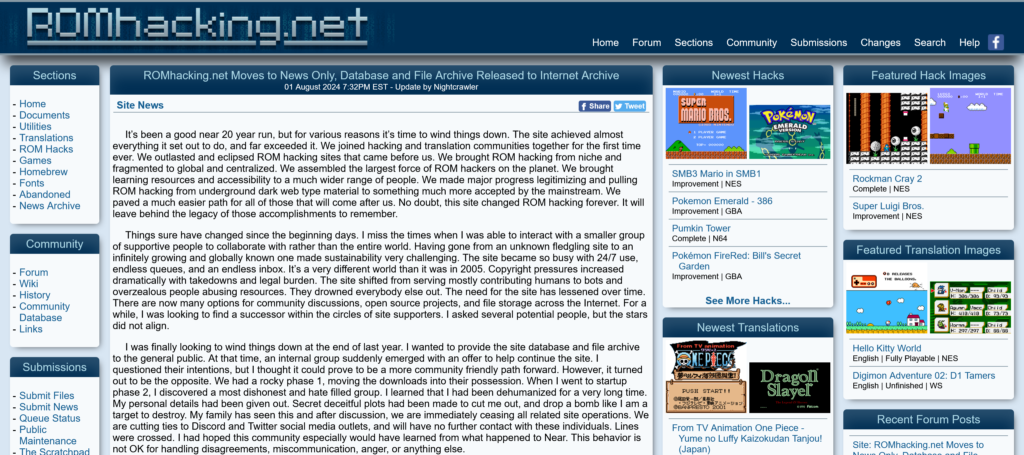
They mention several reasons, but say a collection of users who had offered to take up the site for disingenuous reasons. The details were not mentioned, but they mentioned by way of comparison what happened to emulator author Near, creator of higan, and that can be easily taken as a bad sign.
However, Gideon Zhi on Bluesky offers a different take, that suggests comparison to Near is greatly inappropriate, and that Nightcrawler was severely burnt out and refused offers to help. I don’t know which is more accurate, but the details are offered suggest there may be something to his version of events. Gideon Zhi isn’t one, I think, to cover something like that up. Ah well, drama.
Maintaining a hugely popular website for 19 years is a huge drain on your time, energy and finances. It’s possible that ultimately Nightcrawler needed, or even just wanted, to retire, and that’s okay.
I’ve made frequent use of romhacking.net over the years, both in researching two romhack ebooks and the Romhack Thursday feature on this site. While what the maintainer of romhacking.net says in their news post, that there isn’t as much of a need of a centralized site for collecting and presenting romhacks as there was back in 2005, I still found their site extremely useful, and I think it served a vital role. I will greatly miss it, but I understand their wishing to move on. They took the step of uploading the whole site contents to the Internet Archive, which is a forward-thinking move that I applaud.
Will they ever return to updating the site? Anything is possible, but I expect not. Will another site arise to take its place? Who knows, there’s definitely demand for it. I wish Nightcrawler well in any event, and thank them for their service.
–
Second:
Kotaku reports that Game Informer, the oldest game magazine still in print in the US (dating back to 1991) is shutting down. It was originally a production of the classic game retailer FuncoLand, who would advertise, in turn, in classic 90s gaming magazines, and the publication changed ownership to GameStop when they bought FuncoLand out in 2000.
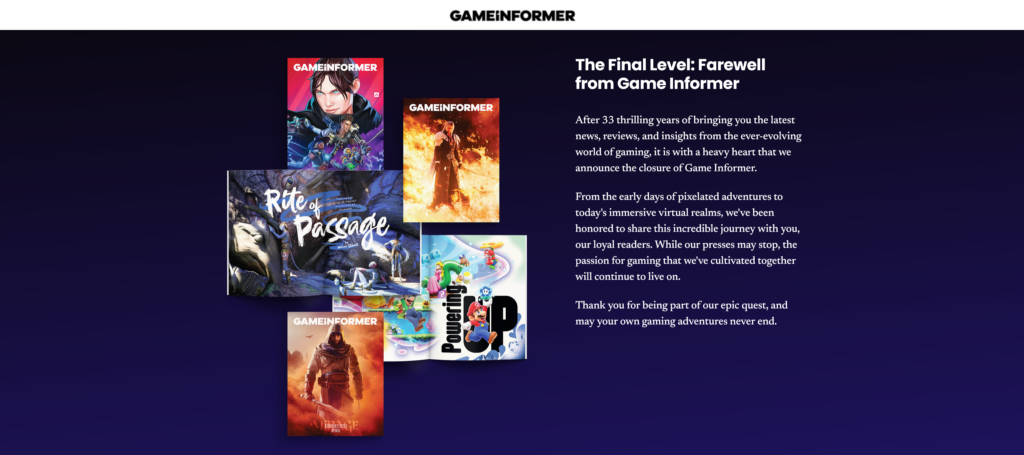
Since then, GameStop has kept the magazine going as a house publication, at times distributing issues for free to customers. It seems the announcement was sudden, with management sending out a tweet about the publication’s closure while staff was being notified of the ending of their positions.
There are older game magazines in Japan, of course, and US game magazines lately have had things pretty tough with competition from the internet. It’s surprising that they’ve managed to keep going for this long.
Looygi Bros. obsessively plays various games and finds quirks, glitches and interesting facts about them. Their newest video tries out a bunch of known glitches in NES games and sees if they work in the new Nintendo World Championships speedrunning game. The result: in many, but not all, cases, Nintendo has put in code traps to make sure the games are operating as intended, and if they are set off, like if Mario goes through a wall or Link wraps around the screen, the emulator software declares Strategy Unavailable and resets the run. They tested 11 glitches in a ten-minute video, embedded here:
To summarize them:
I find it interesting that the tricks were disabled through traps instead of fixing their games, they seem to have enough technical know-how to know how the glitches work to check for them in the emulation layer, but maybe fixing them was deemed against the spirit of the game, or they didn’t want to risk changing the game’s essential behavior?

Sundry Sunday is our weekly feature of fun gaming culture finds and videos, from across the years and even decades.
So despite the fact that you likely already know all of this, I still feel like I have to explain it all for people who might not have soaked their brains in US popular culture, yet still care enough about video games that you’re reading Set Side B. Let’s get it out of the way as quickly as feasible.
Premiering December 17, 1989, The Simpsons has been on the air for approaching 35 years. We in the United States are going to have to come to terms with the fact that it’ll probably be the reigning television fact of our lives. When it began, the NES was still the hot game system, and that was eons ago.
Premiering in the 7th season, during the time when most people still agreed The Simpsons was the best show on television, was the episode 22 Short Films About Springfield, in which the writers created a loosely-connected sequence of miscellaneous stories about the many side characters in The Simpsons. One of those stories was “Seymour and the Superintendent,” where Bart’s principal hosts his boss Superintendent Chalmers to a home-cooked meal, but due to a sequence of comical events serves him Krusty Burgers instead, covers it up in a variety of unlikely lies, and nearly burns down his house. Colloquially this has become known as “Steamed Hams,” after one of the lies Principal Skinner tells.
In 2017, a popular meme went around the internet in which people remade, remixes, or otherwise re-did that story, alone of all of them in the episode, the season, and among the long long run of the show.
In fact, those memes are still being made, and this post’s subject is one of them. It’s a video simulating what a Steamed Hams game would have been like if it were made in the style of the Bart vs the Space Mutants and Bart vs The World games on the NES. It was made by Penney Pixels, it’s four minutes long, and it’s here, and here:
There is an actual game version of the Steamed Hams, of which a playthrough is recorded here, and can be downloaded here. There’s another version of Steamed Hams too, and it can be played on GameJolt here. Both of those are adventure games.
I thought Steamed Hams had come up here before, but a quick search didn’t find anything, so I’ll just leave it at this. I’m sure in the next 35 years there will be hundreds more game versions of Steamed Hams. Maybe after all that time, I’ll be able to bring myself to mention it here again.
The end of Blaseball continues to leave a large squid-shaped hole in what I’m going to, for the sake of argument, call our hearts, but there are alternatives out there. One such alternative is Inty Sports, and the IBL: the Intellivision Baseball League.
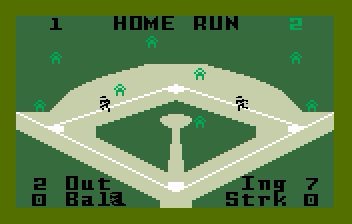
Forget about hacking Tecmo Bowl or the like to include modern stats, this goes all the way back to arguably the first complete home console baseball simulation, back on the first console that made decent sports adaptations a reality.
Since 2014, each year, over the course of around three-and-a-half months, a league of ten teams with names based on Intellivision properties battle it out for the title of IBL Champions. I don’t know if human players back the teams or if they’re all computer-played, but it seems probable that it’s the latter. Intellivision’s Baseball (originally marketed with the Major League Baseball license) is a decent adaptation, although there are some rule changes as described on its Wikipedia page: no fly balls are simulated, home runs are declared based on “how and where” the ball is hit, and if a run is scored before the third out on a play, it counts.
Intellivision Baseball is from an era before consoles tracked stats, named players, or even offered selectable teams, so any strengths and weaknesses on a given team are merely the result of statistical variance. If you can allow yourself to forget about that detail, though, you might allow yourself to be amused, for a period of time ranging from minutes to multiple years.
Each game progresses rapidly, and is over in a brisk 9 to 11 minutes, which is much better than real-life baseball. Inty Sports has a website with the records of past seasons, and a page of greatest moments. Their 2024 season wrapped up just a few weeks ago, and can be viewed on their Youtube channel. Here is the final game of the 2024 season, Spartans vs Bombers (11 minutes):

It occurs to me that it might be a good idea to explain what playing Wizardry is like. There was once a time when this basically was what a CRPG was. JRPGs obscured that greatly and became the new default, but before Final Fantasy took over the world, there was a whole pile of what we might now call Wizardry-likes: The Bard’s Tale series, Dragon Wars, Might & Magic, Dungeon Master, Eye of the Beholder among them.
All of these party-based CRPGs have a lineup, a list of characters that are generally considered to be in order. Dungeon Master arranges them in more of a 2×2 grid, but there’s still a front line and a rear. Key in all of these games is that the front line is where you should put your melee fighters, who are in substantially more danger and need more HP and equipment protection (often directly using the D&D term Armor Class). The rear is where the characters who can’t take a licking go: the thief and your mages. Clerics/Priests generally can go in either area. By tradition they they can still still use most armor, but the problem is they’re usually the party healer, so being in the front line also means they’re more likely to get taken out by Paralysis or Petrification, leaving the rest of the group in the lurch.
It’s vitally important that the front line holds. Characters who get knocked out will get automatically shuffled to the back of the group, putting the squishies in range of the monsters’ unkind claws and teeth. It might be possible to hurriedly cast some AC-increasing spells, but it’s usually just as fast to cast strong attack magic and end the fight, then cure the downed fighters in camp. If you can’t do that… well, then it’s best to find your way back to town by the most expeditious route.
What route might that be? Well that’s why you’ve hopefully been working on a map! You might have played labyrinth games before, or think you can rely on a spatial sense build from playing first-person shooters, but those are not going to suffice here, you need a map. The Digital Eclipse remake of Wizardry maintains one for you, but as previously said it can be “tricked” by two particular types of maze phenomena: spinners and teleporters. Spinners change your facing randomly but leave you in place; suitably, they’re almost always placed in four-way intersections, so it’s not obvious which why you’re now going, or even if you’re going back the way you came. Teleporters usually leave your facing the same, but now in a different location.
I said last time that you should make your own characters, but that will also leave them at experience level 1, which is really weak. Until you reach level 2, every expedition into the dungeon should contain a single encounter. The starting quadrant of the first level has just three rooms. Enter one of them, fight or run from the inhabitants, then run to the stairs. If you used any spells or took any damage, have the affected characters stay at the Inn. It takes a lot of stays to lose even one point of Vim, so it’s nearly free.
If you’re playing with the original Inn, then stays will be more expensive unless you stay at the Stables, which gets you your spells back and nothing else. But that’s okay, because you can then dip into the maze and have your priest cast DIOS on your injured. You can repeat that cycle as many times as you like, and it won’t even age your characters. It almost feels like cheating, but you want to push every advantage you have as far as it will go.
Get used to training up level 1 characters, you’ll be doing it several times. You’ll want a B-team of characters to rescue your main group if need be, a Bishop of moderate level to identify found equipment without paying Boltac’s insane prices, maybe a separate Evil/Good team if you want to try out a Ninja/Lord, and maybe characters to replace failed resurrections from ash. The only time you’ll have to train up a character unaided, though, is the first time.
It is true, one of the modernizations in the Digital Eclipse remake is the ability to outright hire characters of levels approaching your highest experience level reached, but it’s not free, and could end up being really pricey. If you’re broke, then you can’t hire anyone over level 1, and if you have no characters you won’t be able to earn more money. Also, you should know that there’s a limit of 20 characters you can have among all those you have at one time. I don’t know what happens if all of your characters are dead and in the maze at once. Seems like they should have accounted for that possibility, though.
Use every advantage you have! Mages begin with the sleep spell KATINO, and while it’s almost useless later in the game it’s the key to surviving the first floor, that and the priest’s Dispel Undead ability.
There aren’t many monsters that can appear randomly on the first level:
Bubbly Slimes: the weakest monsters in the entire dungeon. They never flee and are immune to sleep spells, but are almost never a danger.
Kobolds: easy to beat unless they outnumber you. KATINO, the sleep spell, works quite well.

Orcs: Like kobolds but a little beefier. Both kobolds and orcs are very prone to running away if you’re even slightly above their level. Use KATINO.
Level 1 Rogues: Also weak and prone to fleeing, and vulnerable to KATINO.
Undead Kobolds: one of the very few (possibly the only) monster in the game with a description of “Skeleton.” For first-level groups kobold skeletons are pretty dangerous, all the numbers of kobolds but without their tendency to run away or vulnerability to sleep. You might be tempted to fight them hand-to-hand for the experience points, but this is just the kind of thinking that gets first-level parties slaughtered. You have a priest; they should be trying to dispel them every turn. (If you don’t have a priest then go right back to town and make one!)
Bushwackers: the horrors of the first floor, they do around a d8 of damage, making them deadly. If a group of first level characters encounters a group of Bushwackers without any KATINOs available it’s best to try to run. Bushwackers can be a problem even for 2nd level parties, but against higher level groups they’re just as prone to fleeing as their lower level compatriots.
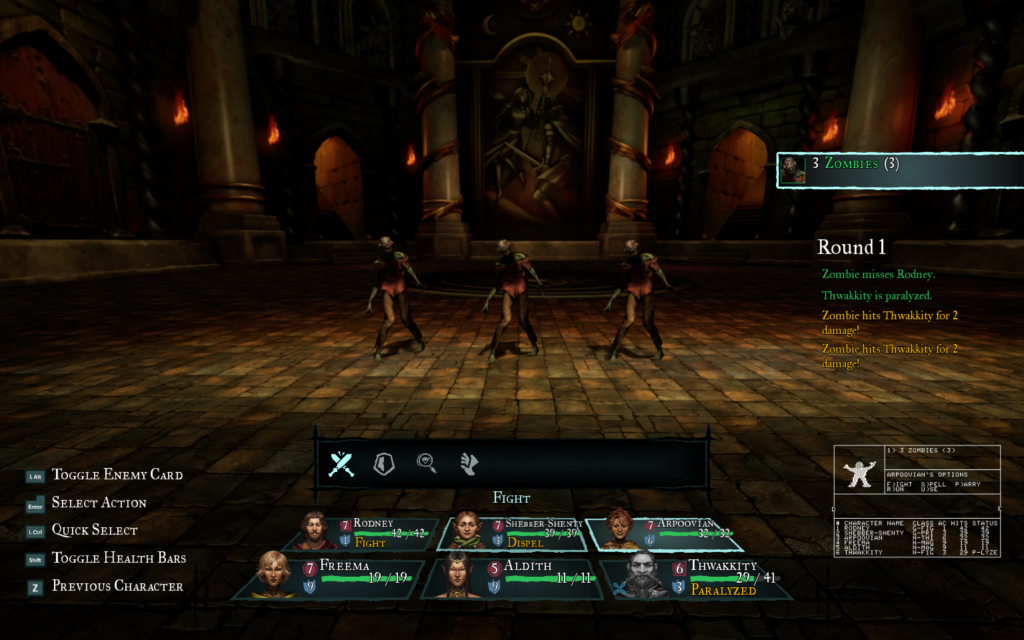
Zombies: about one time in five, a group of Bushwackers will be generated with an assisting team of Zombies. This is by far the most dangerous encounter possible on the first floor, pretty much impossible for a first-level group to defeat without a lot of luck on their side. I’d have the priest try to dispel the Zombies, and use your mage(s) to cast KATINO on the Bushwackers. If you can get all the Bushwackers asleep, maybe use any remaining extra spell slots on HALITO on the zombies, but there is no really good way to survive this. Fortunately Bushwackers+Zombies is a rare combination, I’ve only seen it happen once on the first floor.
There is one more monster that can appear on the first floor….
A beloved monster among Wizardry fans, and something of a legend in the annals of CRPGs, is Murphy’s Ghost. It’s a special encounter that can occur in one specific room on the first level of the dungeon. It’s in a region behind a secret door, so you might not find it until you learn the light spell MILWA, or possibly its longer-lasting version LOMILWA.
In the original, stepping onto its encounter spot was enough to make Murphy’s Ghost appear. Now you have to search to fight them. In both cases though the fight is easily repeatable.
On the first floor, Murphy’s Ghost can appear in groups of up to two. The fight isn’t that difficult, and even against low level characters it can’t do more than 4 hit points of damage every round. The main problem is that Murphy’s Ghost has a very low (that is, very good) Armor Class, at -3, and has many hit points. No attack magic works on the ghost, but spells that worsen its AC, or improve your characters’, work well. It takes around 40-50 melee attacks, on average, to fell a Murphy’s Ghost. One ghost earns 4,450 experience points, which split six ways it still over 700 XP apiece, and a pair of them can be enough to gain a whole level’s worth of experience at once. It is possible, rarely, to earn more experience from other groups on the first level, but Murphy’s Ghost has the advantage of only getting one attack per round, and of appearing every time its room is entered/it’s searched for, even if you just fought it a couple of moves before.
Murphy’s Ghost is slightly less useful in the Digital Eclipse version because the new unskippable battle animations take up a lot of extra time. It was always the combination of easy repetition, battle speed and relatively low difficulty that made fighting Murphy’s host appealing. After your group gets a couple of extra levels on their bones the first floor starts looking a lot less treacherous anyway.
I only have the barest understanding of Japanese, and the auto-translation on this video is pretty bad*, but I still found this Japanese Youtuber’s experience with the Steam release of Epyx Rogue to be interesting (27 minutes):
They keep using terms from Chunsoft’s Mystery Dungeon games, especially Torneko no Daibouken from the Super Famicom, but seem to have a good sense of how those items connect to and were inspired by Rogue.
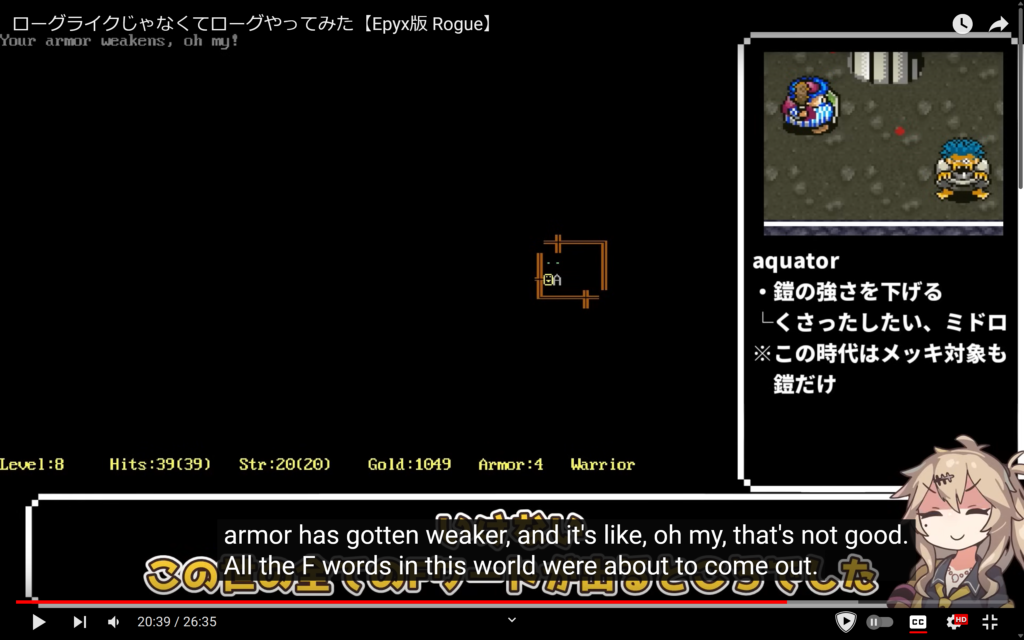
They also die a lot. Because Rogue doesn’t want you to win. It was made for a community of players who would play it over and over, and were competing on shared scoreboards on university machines, and indefinite play makes for a poor measure of player skill. Standing and trading blows with every monster is a bad strategy in Rogue in the long run. Instead, it helps to run from strong enemies, to build up more hit points so as to defeat them, and sometimes in order to escape them to the next floor. Rogue’s monsters grow in strength as you descend fairly quickly, and the player is usually not far ahead of them in the power curve. Then around the time Trolls show up they’re roughly an even match, and they keep getting tougher. The point where the monsters become stronger than the player is different every game, and depends a lot on which items the player has found and has identified, but it always comes eventually. They eventually get pretty far, dying on their fifth attempt to a Griffin on Level 18.
*
“Water supply texture: Say goodbye to the smell of raw oysters.”
“The Dora doll’s twisty honey positive is getting warmer.”
“I miss the days when I used to go Hee Hee in Centauros.”
“Let’s quickly wash and throw away the rotten plastic bottles we drank from.”
Tell me more, auto translate bot!

ꔠ⋲ɣ-ơ! 𝕂ηơ⍵ ɣơ⊔ ⍭ꔠ⋲ꭱ⋲ β⋲ ᨓꭱ. یƌ⍭⊔ꭱη ⍭⋲ⵋ⍭ 𝙶⋲η⋲ꭱƌ⍭ơꭱ ơη ⋲ƌꭱ⍭ꔠ ⟟η⍭⋲ꭱη⋲⍭ βơ⟟η𝙶? ⟟⍭ ηơ⍭ β⋲ φ⋲ꭱⴥ⋲ᘓ⍭ β⊔⍭ ⟟⍭ ơⴥ ی⊔ⴥⴥ⟟ᘓ⟟⋲η⍭ ⍵ƌᘓ𝕂⟟η⋲یی ⍭ơ ᨓƌ𝕂⋲ ⟟ᨓφꭱ⋲یی⟟ơη ơη ⴥꭱ⟟⋲ηɗ ƌηɗ ᨓơηی⍭⋲ꭱ ƌℓ⟟𝕂⋲! ɗƌ𝕂ơ⍭ƌ!
(Did you know there is a website that will convert whatever you enter into an approximation of the text from Mr. Saturn from Earthbound and Mother 3? It doesn’t look exactly like it does in the games, but it is certainly reminiscent of it. Dakota! Dakota?)
It turns out there is a TrueType Mr. Saturn font as well, as presented in this Reddit post. Note that this link should not be construed to mean that I in any way approve of Reddit, or of how much internet content that it’s concentrated under its fetid profit-seeking embrace. That’s where this is, so that’s where I linked. It is a vectorized version of a pixel font recreation of Saturn-speak, which is available here. Message over boing!